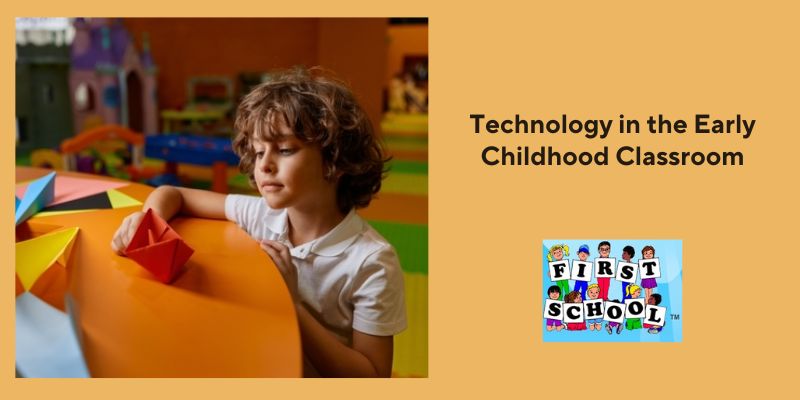Technology in the Early Childhood Classroom

Technology integration in the early childhood classroom has revolutionized how young children learn and interact with the world around them. As digital natives, today's preschoolers are growing up in an environment where technology is a fundamental part of daily life.
Continue reading to explore technology integration in early childhood education, its importance in the classroom, ways to use it effectively, potential disadvantages, and how it can enhance learning for young children.
Technology Integration in Early Childhood Education
Technology integration in early childhood education refers to using digital tools and resources to support and enhance learning experiences for young children. This can include various technologies, such as tablets, interactive whiteboards, educational apps, and online resources.
The goal is to incorporate these tools in a way that complements traditional teaching methods, supports learning objectives, and engages students in meaningful ways:
-
Interactive whiteboards transform lessons into engaging multimedia experiences, fostering collaboration and visual learning.
-
Educational apps can provide targeted practice in letter recognition, numeracy, and problem-solving, often playfully and interactively.
-
Digital storytelling tools allow children to express themselves creatively through pictures, sounds, and narration.
-
Video conferencing can connect children with experts or classmates in remote locations, broadening their perspectives.
-
Simple coding programs can introduce young children to basic programming concepts, fostering critical thinking and problem-solving skills.
Importance of Technology in Early Childhood Classroom
Technology in preschool offers a multitude of benefits, including:
- Engaged Learning:
Technology can capture young learners' attention with interactive features, games, and simulations, leading to deeper engagement with the material.
- Personalized Learning:
Educational apps and programs can be tailored to individual needs and learning styles, ensuring each child progresses at their own pace.
- Skills Development:
Technology use promotes critical thinking, problem-solving, and digital literacy skills essential for success in today's world.
- Accessibility:
Assistive technologies can support children with special needs, allowing them to participate more fully in classroom activities.
- Preparation for Future Education:
Familiarity with technology prepares young learners for the increasingly digital nature of future educational environments.
How Can Technology Be Used in Early Childhood Education?
Implementing technology in preschool education requires thoughtful planning and strategy. Here are some practical ways to incorporate technology in the preschool classrooms:
- Interactive Whiteboards:
These can be used for various interactive lessons, including storytelling, drawing, and educational games.
- Educational Apps:
Apps designed for young children can teach basic skills such as counting, reading, and writing.
- Digital Storytelling:
Creating digital stories using tablets or computers allows children to develop their creativity and narrative skills.
- Virtual Field Trips:
These can provide children with experiences and knowledge about the world beyond their classroom.
- Coding Toys:
Simple coding toys and apps can introduce preschoolers to basic programming concepts in a fun and accessible way.
Disadvantages of Technology in Early Childhood Education
While there are many benefits to integrating technology in the classroom, it's essential to be mindful of specific considerations to ensure a balanced and healthy approach:
- Screen Time Management:
Monitoring screen time helps maintain healthy sleep patterns, attention spans, and physical activity levels.
- Encouraging Social Interaction:
Combining technology with traditional play and group activities promotes the development of crucial social skills.
- Quality Content Selection:
Choosing high-quality, age-appropriate educational apps free from advertising ensures positive and enriching learning experiences.
According to the data, screen time for children aged 2 to 5 should be limited to one hour daily. Screen time should also be balanced with other activities that promote physical, social, and cognitive development.
In What Ways Technology Can Enhance Early Childhood Learning?
To ensure that technology in early childhood education complements traditional play and hands-on learning, educators can adopt the following strategies:
- Balanced Integration:
Use technology to complement traditional activities. For instance, follow up on a digital storytelling session by drawing or acting out the story.
- Interactive Play:
Combine digital and physical activities. For example, a tablet can guide a treasure hunt that involves physical movement.
- Collaborative Learning:
Facilitate group projects and collaborative tasks with technology, encouraging teamwork and peer learning.
- Parent Involvement:
Engage parents in their child's digital learning at home to reinforce classroom lessons.
Final Thoughts
Integrating technology in the early childhood classroom enhances engagement, personalizes learning, and develops essential skills. Effective use requires managing screen time, combining digital and traditional activities for social interaction, and selecting high-quality, age-appropriate content.
First School balances technology with traditional methods, ensuring children benefit from digital and hands-on learning. Our programs prioritize interactive and collaborative activities that support overall development, making us a trusted choice for comprehensive early childhood education.
Empower Your Child with First School’s Advanced Learning Solutions
Explore why integrating technology in the early childhood classroom is essential! At First School, we enhance learning through innovative tools that promote creativity and skill development. Our approach combines digital resources with hands-on activities, ensuring a balanced and engaging educational experience.
Contact us today to discover how technology can enrich your child's early learning journey at First School.
FAQs
- Is technology making children's lives better?
When used appropriately, technology can improve children's lives by enhancing learning, creativity, and access to information.
- Do kids learn better with technology?
Kids can learn better with technology as it provides interactive, personalized, and engaging educational experiences.
- How much technology is too much for a child?
Too much technology for a child is when it exceeds recommended screen time limits, hinders physical activity, and social interaction, disrupting sleep patterns.
- Is screen time bad for kids' eyes?
Excessive screen time can strain kids' eyes and potentially lead to vision problems.
This entry was posted in Early Childhood and tagged Early Childhood Development
Comments are closed









